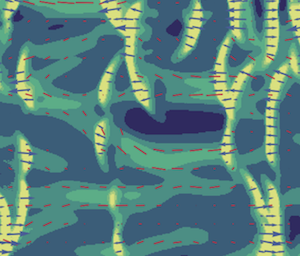Pattern-induced local symmetry breaking in active matter systems

The emergence of both macroscopic order and spatiotemporal patterns are hallmarks of active-matter systems. In conceptual theoretical models, the symmetry of the ordered states, such as polar travelling waves and nematic bands, has been linked to that of the underlying microscopic interaction between the constituent particles. Recently, this close link was challenged by experiments with actomyosin motility assays (Huber et al, Science, 2018). There it was observed that patterns of polar and nematic symmetries can be firmly intertwined: they can coexist, interact and even dynamically transform into each other. However, a theoretical understanding of this fascinating phenomenon of the dynamic coexistence of ordered states with different symmetries is lacking.
In our recent work, we propose a general mechanism for this sort of phenomenology that is based on pattern-induced local symmetry breaking. We formulate a kinetic theory for (self-)propelled particles that undergo alignment interactions with a tunable symmetry that allows for a polar bias. In a parameter regime of moderate density and moderate polar bias, we indeed find dynamic coexistence between nematic band patterns and polar waves. Combining stability analyses and numerical simulations, we identify a novel mechanism that explains this coexistence in terms of a local symmetry-breaking instability that originates within nematic bands: While the system initially forms nematic bands in a parameter regime of macroscopic nematic order, the density at the core of the bands grows and eventually crosses a density threshold to macroscopic polar order. This spatially local crossing of a critical threshold value in the particle density—a control parameter—triggers local symmetry breaking towards polar order, and thereby results in the self-organized formation of polar waves. We corroborate this hypothetical mechanism by deriving hydrodynamic equations that yield a phase diagram, which is qualitatively similar to that given by our kinetic approach. Furthermore, numerical simulations of our hydrodynamic equations are consistent with this picture, giving rise to tightly entangled dynamics between nematic bands and polar waves that strongly resemble the experimental observations in the actomyosin motility assays cited above.
Our results not only provide new insights into pattern formation in active matter but also reveal a novel mutual feedback mechanism between pattern formation and symmetry breaking. We are convinced that this feedback is not limited to our specific study, but is very probably a more general principle that comes into play whenever a control parameter (such as density) is dynamically redistributed during pattern formation. This could apply to a broad range of biological and synthetic active-matter systems with chemical interactions (e.g. collective sensing in bacteria) and behavioural adaptation (e.g. in social learning).

